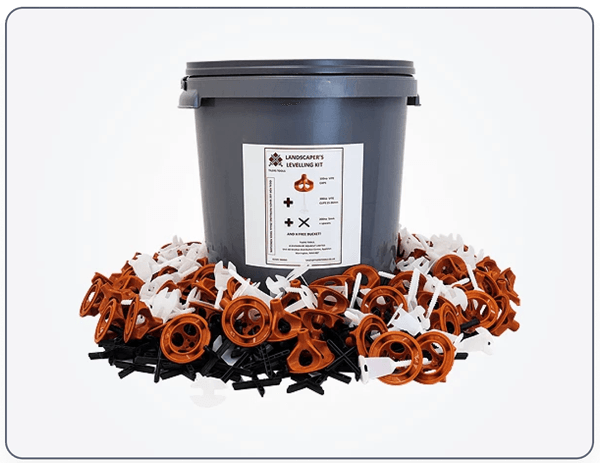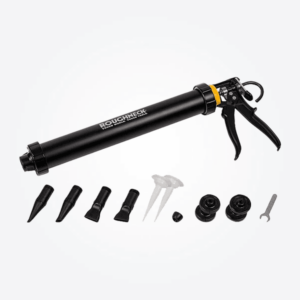Tiling Grout, Paving Grout & Porcelain Grout
Premium Tile Grout for Professional Tilers and Landscapers
The Ultimate Grout Solutions for Every Surface
In the world of tiling and paving, the right grout can make all the difference. It’s not just about filling gaps; it’s about ensuring longevity, aesthetic appeal, and the perfect finish. At Tilers Tools, we understand the nuances of different surfaces and the unique requirements they bring. That’s why we’ve curated a specialised range of grouts tailored for various applications, ensuring that every project you undertake is a masterpiece. Our masterful grouts can be used an indoor and external grout, paving grout and porcelain grout. They also come in a range of finishes including grey, anthracite, jasmine & limestone.
If you are looking to buy tile grout online or at our trade counter, please browse our range below or get in touch.
-
FUGA-PAVE Flex CH Grout
£14.99 – £45.99 exc. VAT
Searching for grout for paving slabs, external grout applications, or porcelain grout? Tilers Tools offers the above range of Tiling Grout products, all of which can be ordered online or purchased directly from our Trade Counter in Appleton, Cheshire. Beyond tile grout, we also provide an extensive selection of professional tiling tools and equipment, catering to both general tilers and landscapers.
Our Tile Grouts Have Versatile Applications
Indoor and Outdoor Tiling Grout
Paving Grout
Porcelain Grout
Our Flagship Fuga Pave Flex CH Grout
Our FUGA-PAVE Flex CH grout is part of our FUGA-PAVE ABC system, formulated for landscaping professionals and ideal for use when installing porcelain, natural stone, cementitious flags, cobbles, or in fact any external installation. FUGA-PAVE ABC is very simple to use. Just mix Part A (hybrid mortar cement) with suitable clean grit sand and water. Part B (slurry primer) and Part C (hybrid grout) are each mixed with clean water. No other additives are required. This complete system offers various cost and installation benefits, beating the traditional system.
FUGA-PAVE products are as simple as ABC and are manufactured exclusively for Tilers Tools.
Popular Grouting Products
-
Clean-It Heavy Duty Cleaner
£12.99 – £33.79 exc. VAT -
-
FUGA-PAVE Flex CH Grout
£14.99 – £45.99 exc. VAT -
-
Seal-It Universal Water Based Sealer for Natural Stone & Porcelain
£29.99 – £149.99 exc. VAT -
Macchia High-Speed Cleaning Machine
£1,292.00 exc. VAT -
Berta Sponge Machine (110V)
£1,535.99£1,298.00 exc. VAT -
Remove-It Rust Remover
£24.99 exc. VAT -
Remove-It Grout Haze Remover
£9.99 – £28.49 exc. VAT -
Remove-It Algae and Black Spot Remover
£49.99 exc. VAT -
Remove-It Oil and Grease Remover
£16.99 exc. VAT -
Our Popular Tile Grout Tutorials
Watching Tilers Tools Tile Grouting videos is an invaluable resource for both novices and professionals aiming to master the art of grouting. These comprehensive tutorials offer step-by-step guidance on how to effectively use our top-notch grout products and tools. Whether you’re working on an outdoor project and need insights on grouting for outdoor tiles or you’re dealing with delicate porcelain grout, these videos have you covered. With a keen emphasis on tile grout techniques and best practices, Tilers Tools ensures that viewers walk away with a wealth of knowledge, ready to tackle any tiling project with confidence and precision.
Frequently Asked Tiling Grout Questions
How long does grout take to dry?
Grout drying time can vary based on the type of grout used, the conditions of the environment, and the application method. Here’s a general guideline for different types of grout:
Unsanded Grout:
- Initial Set Time: Usually takes about 2-3 hours to set to the touch.
- Full Cure Time: Typically takes 24-48 hours to fully cure. It’s recommended to avoid walking on the tiled area during this time.
Sanded Grout:
- Initial Set Time: Like unsanded grout, it takes about 2-3 hours to set to the touch.
- Full Cure Time: Generally requires 24-48 hours to fully cure.
Epoxy Grout:
- Initial Set Time: Epoxy grout sets faster, often within a few minutes to an hour.
- Full Cure Time: Takes about 24 hours to fully cure.
Premixed Grout:
- Initial Set Time: Varies by product, but generally takes a few hours to set.
- Full Cure Time: Typically requires 24-72 hours to fully cure.
Environmental Factors:
- Humidity: High humidity can slow down the drying process, while low humidity can speed it up.
- Temperature: Cooler temperatures can prolong drying times, while warmer temperatures can speed up the process.
- Ventilation: Good ventilation can help grout dry faster.
Recommendations:
- Always follow the manufacturer’s instructions on the grout packaging for specific drying and curing times.
- Even after the grout has dried to the touch, avoid exposing it to water (like in a shower) for at least 48-72 hours to ensure it has fully cured.
- If you’re sealing the grout, wait until it’s fully cured before applying the sealer.
Remember, while the grout may feel dry to the touch within a few hours, it’s essential to allow it to fully cure before exposing it to regular use or moisture.
How to soften grout for removal?
Softening grout for removal is essential when you’re looking to replace or repair tiles without damaging them. Here’s a step-by-step guide on how to soften grout for easier removal:
1. Safety First:
Wear Safety Gear: Always wear safety goggles to protect your eyes from flying grout particles. A dust mask can also be beneficial to prevent the inhalation of grout dust.
Protect the Area: Lay down drop cloths or plastic sheets to protect surrounding areas from dust and debris.
2. Manual Scraping:
Grout Saw or Scraper: Start with a grout saw or scraper to manually scrape away the top layer of the grout. This will help in removing the bulk of the grout.
Utility Knife: For smaller areas or for precision, you can use a utility knife. Be careful not to scratch the tiles.
3. Use a Vinegar Solution:
Prepare the Solution: Mix equal parts of white vinegar and warm water in a spray bottle.
Apply: Spray the vinegar solution onto the grout lines and let it sit for at least an hour. The acidity in the vinegar will help soften the grout.
Scrub: After allowing the solution to sit, scrub the grout lines with a stiff-bristled brush.
4. Steam:
Steam Cleaner: If you have access to a steam cleaner, it can be an effective tool for softening grout. The heat and moisture from the steam can help loosen the grout, making it easier to remove.
5. Commercial Grout Removers:
Purchase a Grout Remover: There are commercial grout removers available at hardware stores that can help soften and dissolve grout. Follow the manufacturer’s instructions when using these products.
Apply: Typically, you’ll apply the solution to the grout lines and wait for the specified time.
Scrub: Use a scrub brush or grout brush to scrub away the softened grout.
6. Power Tools:
Rotary Tool with Grout Removal Attachment: If you’re dealing with a large area or particularly stubborn grout, a rotary tool (like a Dremel) with a grout removal attachment can be very effective. Be sure to use the tool on a low setting to avoid damaging the tiles.
7. Clean Up:
Once you’ve removed the grout, clean the area thoroughly to remove any grout dust or residue. A mixture of water and a mild detergent can be effective.
Tips:
Always test a small, inconspicuous area first to ensure you don’t damage the tiles.
If you’re unsure about the type of grout used (e.g., epoxy grout), it’s best to consult with a professional or do further research, as some grouts may require specific removal techniques.
Remember, patience is key. Take your time, and be gentle to avoid damaging the tiles or surrounding areas.
Is Grout Waterproof?
Grout, in its basic form, is not entirely waterproof. Here’s a breakdown of its properties:
Cement-Based Grout: Traditional grout, which is often cement-based, is porous. This means that while it might repel water to some extent due to its dense nature, it can still absorb water if exposed for extended periods. Over time, this can lead to problems like mold growth, staining, and degradation of the grout itself.
Epoxy Grout: Epoxy grout is more waterproof than cement-based grout. It’s made from epoxy resins and a filler powder, making it extremely durable and almost completely resistant to water and stains. Epoxy grout is often used in areas that are frequently exposed to water, like showers.
Additives: Some cement-based grouts can be mixed with additives to enhance their water-resistant properties. These additives can help reduce the porosity of the grout, making it more resistant to water absorption and staining.
Sealing: To enhance the water resistance of cement-based grout, it’s common practice to apply a sealer after the grout has cured. The sealer fills the pores of the grout, creating a protective barrier against water and stains. It’s essential to reapply the sealer periodically, especially in areas with frequent water exposure, to maintain its effectiveness.
In summary, while basic cement-based grout is not entirely waterproof, its water resistance can be enhanced through additives and sealers. Epoxy grout, on the other hand, is inherently waterproof due to its composition. If you’re tiling an area that will be frequently exposed to water, it’s crucial to choose the right type of grout and take additional measures, like sealing, to ensure longevity and prevent water-related issues.
How to Clean Grout
Cleaning grout can refresh the look of your tiles and prevent mold and mildew growth. Here’s a step-by-step guide on how to clean grout effectively:
1. Gather Supplies:
Soft scrub brush or an old toothbrush
Spray bottle
Bucket
Clean cloths or towels
Rubber gloves (optional)
2. Basic Cleaning:
Warm Water: Start by wiping the grout with warm water and a clean cloth to remove surface dirt and grime.
Brushing: Use a scrub brush or toothbrush to scrub the grout lines gently. This can help remove any loose dirt or debris.
3. Homemade Grout Cleaners:
Baking Soda and Water:
Make a paste of baking soda and water.
Apply the paste to the grout lines.
Let it sit for a few minutes, then scrub with a brush.
Rinse with clean water.
Vinegar Solution:
Mix equal parts of white vinegar and warm water in a spray bottle.
Spray the solution onto the grout lines.
Let it sit for a few minutes, then scrub with a brush.
Rinse with clean water. (Note: Do not use vinegar on natural stone tiles like marble or limestone as it can damage the stone.)
Hydrogen Peroxide: If you have stubborn stains or mold/mildew, you can apply hydrogen peroxide (available in most drugstores) directly to the grout or mix it with baking soda to make a paste. Scrub and rinse as usual.
4. Commercial Grout Cleaners:
There are many commercial grout cleaners available in stores. Always follow the manufacturer’s instructions when using these products. Ensure the product is suitable for your type of tiles, especially if you have natural stone tiles.
5. Deep Cleaning:
For extremely dirty or stained grout, consider using a steam cleaner. The steam can help loosen and lift deep-set grime and stains.
6. Rinse and Dry:
After cleaning, rinse the area thoroughly with clean water to remove any cleaning residue. Wipe the tiles and grout with a clean cloth and let them air dry.
7. Preventative Measures:
Sealing: After cleaning, consider sealing the grout to protect it from future stains and make cleaning easier. There are various grout sealers available, so choose one that’s appropriate for your type of grout and tiles.
Regular Maintenance: Wipe down wet areas (like showers) regularly to prevent mold and mildew growth. Regularly sweeping and mopping floors can also prevent dirt buildup in grout lines.
Remember, always test any cleaning solution on a small, inconspicuous area first to ensure it doesn’t damage or discolor the grout or tiles.














